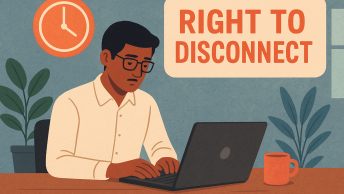For now, debates on OBC quotas are on hold, as we wait for the Supreme Court’s next move on May 08. But it is becoming clear that the quota issue is but one among many that are at the heart of the recent institutional struggles between the Judiciary on the one side, and the Executive and the Legislature on the other.
On April 26, Lok Sabha Speaker Somnath Chatterjee addressed the overall issue squarely while delivering a public lecture. Excerpts from that speech are carried in this column in the April 27 issue of the Indian Express. For the most part, the lecture covers fairly conventional analysis, focusing on the roles of the three wings of government, and quite predictably, making the case that the Indian Judiciary should respect the constitutional powers of the Parliament and Executive.
I was drawn to the section where Chatterjee focuses on some recent judicial actions which he considers problematic, though he prefaces that statement by making the reasonable (and necessary) concession that judicial review is of course entirely legitimate. This is refreshing, particularly in view of recent statements by members of other Left parties, which seem to betray a misunderstanding of basic notions of constitutionalism, by asserting that the Indian constitutional regime is one where parliamantary supremacy is the governing rule.
“NO ONE can take exception to any decision in the exercise of judicial review (subject, of course, to the provision of review or appeal, where it lies) invalidating any law or executive action, but where it seeks to lay down some new policy to be adopted or actions to be taken and uses its supposed power to compel executive action on the same without any known authority or procedure, serious questions necessarily arise about the source of such power. Now-a-days, there are umpteen instances where the judiciary has intervened in matters entirely within the domain of the executive, including policy decisions. Recently, a media correspondent has compiled a list of issues and matters in which the courts have apparently, if not clearly, strayed into executive domain or in matters of policy. He has noted that the orders passed by the hon’ble high court of Delhi in recent times dealt with subjects ranging from age and other criteria for nursery admissions, unauthorised schools, criteria for free seats in schools, supply of drinking water in schools, number of free beds in hospitals on public land, use and misuse of ambulances, requirements for establishing a world class burns ward in the hospital, the kind of air Delhiites breathe, begging in public, the use of sub-ways, the nature of buses we board, the legality of constructions in Delhi, identifying the buildings to be demolished, the size of speed-breakers on Delhi roads, auto-rickshaw over-charging, growing frequency of road accidents and enhancing of road fines. The Jagadambika Pal case of 1998, involving the Uttar Pradesh Legislative Assembly and the Jharkhand Assembly case of 2005, to my mind, are two glaring examples of deviation from the clearly provided constitutional scheme of separation of powers. The interim order of the Supreme Court in these two cases, to my mind, upset the delicate constitutional balance between the judiciary and the legislature. I feel that these were instances of unfortunate intrusion by the Supreme Court into well-demarcated areas of powers of the legislatures, contrary to the provisions of Articles 122 and 212 of the Constitution. Chief Justice Verma has recently described the orders in the UP and Jharkhand cases as judicial aberrations and has expressed his hope that the Supreme Court would soon correct them.”In the subsequent sections, Chatterjee focuses on the principles of constitutionalism which counsel against such aggressive judicial actions. Again, much of this is trite, and this could well be an abstract academic paper discussing principles without referring to any specific country, because Chatterjee seems to ignore the realities and political factors in India which have led over time to the judiciary adopting such an aggressive position. It is only towards the end of the lecture that Chatterjee implicitly recognises this, when he asserts:
“ALMOST all votaries of judicial activism, including the hon’ble judges themselves, while exercising power in such assumed jurisdiction justify it on the supposed failure of the legislature or the executive authorities in taking proper action to mitigate the people’s grievances or to find solutions to people’s problems.”
Chatterjee’s response is interesting, because it seems to concede the force of this criticism. He does not seek to refute it, but focuses instead on the judiciary’s institutional incapacity to address these problems on its own:
“But with regard to dispensation of justice, how many ordinary citizens of the country, who are oppressed and subjected to various forms of discrimination and denial of rights, particularly women who are victims of torture and exploitation, can have access to the courts, specially the highest court of our country? How many dismissed employees, how many victimised teachers, how many senior citizens, how many disadvantaged people staying in far flung areas of the country who would need to seek justice can approach the apex court of our country? The geographical distance, prohibitive cost of litigation, inordinately long time taken for disposal of matters, discourage or otherwise make it impossible for ordinary litigants to approach the court. The large number of arrears pending in almost all the courts is affecting the people’s faith in our justice-delivery system. These issues require to be given very serious attention not only by the legislature or the executive but also by the judiciary. One has to admit that in many instances the judiciary (without attributing any fault to it) is not able to cater to the needs of the common people of the country in adequate measure. Now, in such a case, can any other organ of the state take up on itself the right to exercise judicial powers on the plea that judiciary has not adequately been able to do so?”It is interesting to contrast the Speaker’s take on the issue with that of Rajeev Dhavan who addressed the same issues in an op-ed piece which appeared in the April 27 issue of the Indian Express). Dhavan’s piece, reflecting his academic background as well his current role as a leading Supreme Court lawyer, provides a historical perspective of the tussles between the three wings of government and lays out four broad categories of judicial actions that he terms “areas of discontent.” Dhavan concludes that “[w]e are in the midst of a controversy as big and complex as the property and sovereignty controversies of the Nehru and Mrs Gandhi eras. “
While Dhavan’s tone and style throughout the piece is academic and objective, there is one issue on which his comments are quite scathing. This is in reference to the Supreme Court’s intervention in the Forest cases, and this is what he has to say:
“Can a case concerning forests go on for years — with decision-making shared with an amicus and a Supreme Court created committee that holds hearings with pride and prejudice as if it were a consultative wing of the Supreme Court.”
Interestingly, this is strikingly similar to the argument adopted by the Additional Solicitor General in opposing the Supreme Court’s continued intervention in the forest cases. More details of the latest order in the Forest case, including the argument of the ASG resisting judicial intervention, can be found in this newsreport from the April 27 issue of the Indian Express.
Even if the OBC quotas issue gets resolved equably (and there don’t seem many signs of that as of now, given the strident statements issued by politicians over the past few days), the leaders of the three main institutions of Indian goverment will have to adopt sagacious steps to avoid a constitutional crisis in the coming months.
Update, May 03: The full text of the Speaker’s speech is available here.






Dear Mr.Arun,
I was looking forward to Mr.Vivek Reddy’s well-researched Part II on the Myths on Indra Sawhney Judgment. But your stand that debates on OBC quotas are on hold till May 8 was a disappointment. I hope we, in this blog, are not imposing on ourselves the sub-judice rule, followed by the rest of the media rather unconvincingly. Whatever the SC’s move on May 8, I feel our debates could continue in a general/academic sense, rather than excessively speculate on the outcome of the case -not because it would be sub-judice, but it serves no purpose. But the debate should continue, if we find time to contribute, and add to our scholarship and understanding of unexplored areas notwithstanding the May 8 hearing. If some of us (including me) exceed this brief, may be we could be politely requested not to.
Secondly, there is one thing in Somnath Chatterjee’s speech which needs elaboration, and your analysis. He says if executive inaction could be a ground for judicial activism, can it be the reverse, that is, can executive/legislature intervene to perform judicial functions, if the Judiciary is seen to be wanting? For example, the consequences of judicial delays for administration and governance – can this be limited by executive/legislature intervention? Although conceptually, these two can be juxtaposed, I feel the argument that it is the legislature/executive which may be responsible for the Judicial aberrations may well be true. Judicial delays, instance, could be attributed to failure to allocate enough funds by the Executive for strengthening infrastructure, to fill vacancies, etc.
Dear Mr. Venkatesan,
I did not mean to suggest that anyone (including those of us on this blog) should put the debate on hold simply because the Court is seized of the matter. I have always found it strange how people interpret the sub-judice rule – I certainly do not think the rule precludes discussion of issues by members of the public simply because they happen to also be under consideration by the judiciary in a pending case.
I was merely describing the media’s lack of attention on this issue, and the relative silence on our blog as well. My sense was that people would rather wait and see how the issue develops, before reacting with their particular positions. I agree with you that discussions about the issue should continue nevertheless, and like you, I too am waiting for Vivek’s promised second post.
As to your second point, I too was a bit puzzled by the question on which Chatterjee ends (or, more correctly, the question with which the column containing the excerpts ends). I initially assumed he was asking a rhetorical question, to buttress his main point that institutions should stick to their established roles. I am not sure he was suggesting that other wings should take up the judiciary’s functioning, even though we do have historical examples, such as Indira Gandhi’s attempt during the Emergency to set up executive-controlled tribunals to supplant the jurisdiction of the High Courts. Articles 323 A and B are still reminders that that may still happen, though the Supreme Court has mitigated such a possibility through its interpretation of these provisions in the Sampath Kumar and L. Chandrakumar cases.
Do you think he was issuing a veiled threat to the judiciary? I still think he wasn’t, but I’d like to see you develop this point, if you think this is leading somewhere specific.
As to delays caused by the executive, it may be worth recalling that successive Chief Justices have complained about the fact that they have recommended appointments to the large number of vacancies in the High Courts, but the relevant governments are holding them up for various reasons, and thereby adding to the delays. We have had some cases (such as in Tamil Nadu) where executive governments have stalled appointments because they did not agree that the persons being recommended were suitable. But that may emanate from a justifiable grievance about the closed and self-controlled nature of judicial appointment, an issue around which there is a growing consensus.
There is no time frame within which the government or court(s)
should take decision on a matter.
When a matter is pending before court(s) can executive/legislature
intervene and perform judicial
functions.But what exactly is meant by judicial function.When
courts are forced to take some
decisions/give judgments that
become policies, in the absence
of the lack of will or lack of
initiative of the executive/
legislature should we blame the
Supreme Court for playing the role
of policy making. Visaka case is an example.Even after a decade there is no legislation on sexual harassment in workplaces.In pollution cases the inaction/indifferent attitude
of powers that be is too well known. Did MPs and MLAs agree voluntarily to declare their
assets when they contest in polls.
Not all may be well with courts,
but things are worse with the political class. That is why
despite all problems one has to
defend judicial activism because
that seems to work in many cases.
See also the edit piece of last week’s EPW.
The political class is restless because their hegemony is under
threat. They have realised that
over the years the weapon of constitutional amendment has been
blunted by the courts.
But who represents ‘We, the people’ in India.We, the people
feel like having been let down
by all the three organs.
Dear Arun,
Glad to know that we are on the same boat on the misconception of sub-judice rule. I clearly got your intro on your post wrong. Thanks for the clarification.
On Somnath’s speech, it was certainly a rhetorical question, to rebut the justification for judicial activism – even though those who pose that question, or support it, don’t know in specifics what they mean.